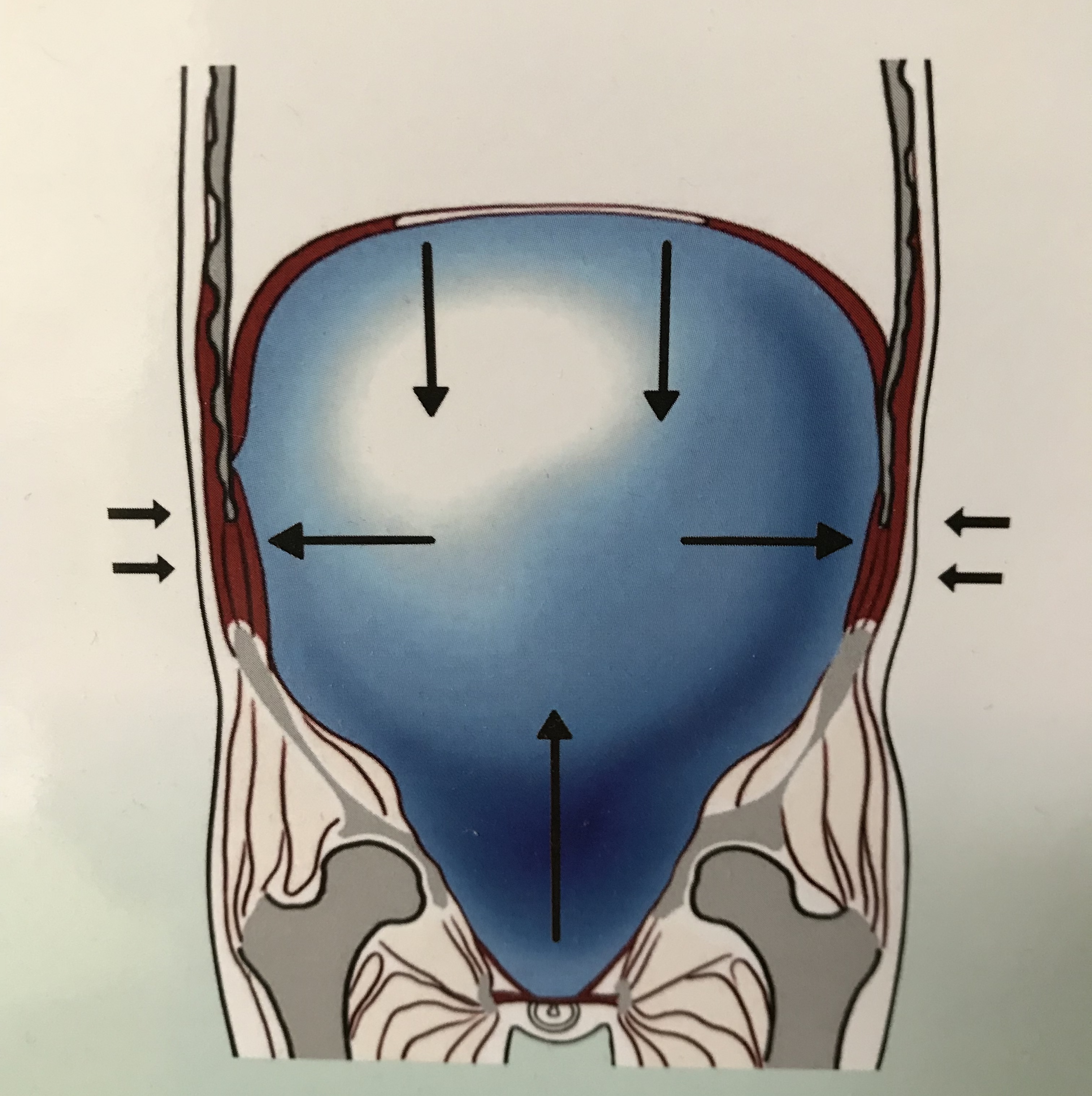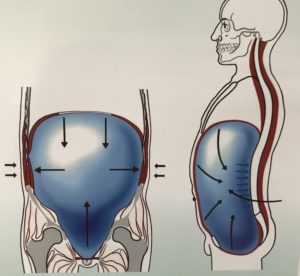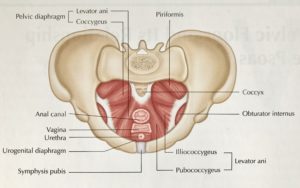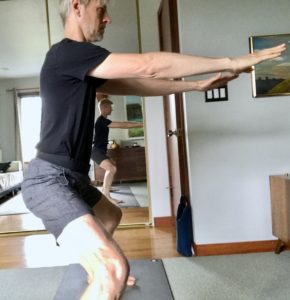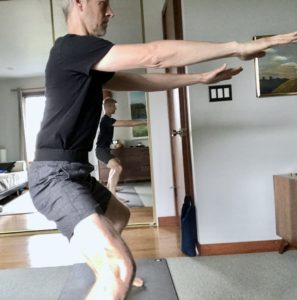Your Diaphragm is a Back Muscle!
in DNS, Health Article, Health Tips, Movement Article, Personal Alignment Training, Videosby Tiffany Turley
When you think of your diaphragm you probably think of it as something that helps you breath and not much more than that. But your diaphragm is actually one of your major back muscles! Because of its attachments to the spine, ribs and sternum, the diaphragm is integral in supporting the joints and disks of the back and in keeping your spinal column upright and stable.
How do we keep this muscle strong and healthy? Diaphragmatic breathing. When we inhale and the diaphragm contracts, it moves downwards, not upwards like we might imagine. This downward movement creates an expansion of the lower ribs, waist, lower back and front of abdomen. This expansion is caused by pressure that builds with the downward movement of the diaphragm in the abdominal cavity called intra-abdominal pressure (IAP).
Optimal IAP causes a relatively even, 360 degree expansion of the abdominal cavity. To visualize this, imagine a circle expanding evenly into an even larger circle. The inner circle is the abdominal cavity while the outer circle is abdominal wall. The optimal expansion of IAP sends a signal to abdominal wall, formed by the trunk muscles including many of the abdominal muscles, to gently contract against this pressure. When these muscles respond appropriately to IAP, the abdominal muscles expand (stretch) and contract (resist) at once. This response maintains the pressure so that your organs, joints and disks are protected.
A healthy back is one that is upright without excessive lordosis (arching in) or kyphosis (rounding out). When we consider the essential role of the diaphragm in developing and maintaining a healthy spine, it is abundantly clear that diaphragmatic breathing is a necessity for spinal health.
So why is it that so many adults don’t breath diaphragmatically? As adults we may adopt one of several different dysfunctional breathing patterns. This is mainly due to 3 factors:
1) Cultural ideas about posture and breathing:
It’s common for many of us to have been exposed to certain ideas and expectations regarding our posture. We may have been told we need to “stand up straight” or “open up our chest.” Dysfunctional habits such as pulling our shoulders back or taking deep chest breaths to improve our posture often manifest as a result of misunderstandings about how and why to improve posture, and these habits often lead to chronic chest breathing rather than diaphragmatic breathing.
2) Breathing in and out of our mouth
When we mouth breath, the air is not pulled down as deeply into the lungs because the diaphragm does not fully contract. Mouth breathing is not only shallow breathing, it also recruits the upper back and neck muscles and this can, over time, contribute to chronic tension in the neck and shoulders.
3) Tightening the abdomen to “flatten the stomach” and brace the lower back.
For those with lower back pain, tightening the rectus abdominus, or our main abdominal “tucking muscle,” might be relieving, temporarily. But remember, in order for you diaphragm to support your back you need to have the appropriate amount of IAP. For the right amount of IAP, your abs need to need to be able to expand on inhalation. Also remember that your diaphragm needs to be able to move downward to create IAP, and it can’t do that if your abs are held tight. “Sucking it in” creates a dysfunctional tension that will only make your back tighter and weaker with time.
So how do you strengthen your diaphragm in a way that is good for your back? Just like with any other muscle it takes practice to re-learn how to use the diaphragm properly and time devoted daily to challenging it and making it capable of responding when called upon.
A very basic posture called “3 Months Supine” is a great way to start improving the function of your diaphragm and restore your abdominal responsiveness. Watch the video below for some simple cues on how to perform this very powerful and fundamental posture.
Diaphragmatic breathing will change your life. It has changed mine.
For more instructional videos and supporting content, follow us on Instagram at robertbrookyoga.
Success in Yoga: Applying DNS Principles to Classical Yoga Postures For Better Asana
in DNS, Movement Article, Videos, YogaAs I continue to explore the various ways that Dynamic Neuromuscular Stabilization (DNS) informs my movement and that of my clients, I continue to be impressed with how well DNS complements my practice and my teaching of yogasana (yoga postures). Classical yogasana are varied and complex, but they are always informed by the movement skills we bring to them. If those skills are limited or flawed in some way, so too will the be postures. When our movement skills are intelligent and aware those qualities will also be expressed in our asana and they will help us to bring our postures to life.
Thus far, after more than 25 years of study and practice, I have not yet found an approach to yoga that complements my practice and my teaching and that facilitates deeper knowledge of the subject the way that DNS has, and there’s every indication that will continue. As my knowledge and understanding of alignment, movement and asana grows I hope to share more of what I learn with you in the form of the posts and videos that Tiffany and I are creating and making available here on our website.
The following video shows part of sequence I’ve been working on for a while now and one I’ve begun to share with many of you in our sessions. If you are unfamiliar with the content, this video is by no means a substitute for skilled instruction. If you wish to explore the postures demonstrated in the video, I would caution you only to do so if you’re already familiar with these postures and to avoid continuing them if you experience any pain or are recovering from an injury that would make such postures inappropriate. Of course feel free to contact me for help or advice!
A Deeper Look at Pelvic Floor Strength and How to Build It – Part 1
in DNS, Health Article, Movement Article, Personal Alignment Training, VideosA quick online search for “strengthen the pelvic floor” reveals a lot about how many of us view the pelvic floor and its role in our health and function. There are any number of recommended exercises for the pelvic floor, some that include products to assist you, and with most advocating an approach that involves isolating the contraction of the pelvic floor muscles. This approach can be helpful for building some basic awareness of the pelvic floor – an important component of developing pelvic floor strength. But this approach is also limited in that it fails to address the broader and more essential role of the pelvic floor in facilitating alignment and functional movement.
The Pelvic Floor Does Not Work in Isolation
The pelvic floor muscles coordinate with several deep muscles in the trunk in order to stabilize the lower trunk and maintain the integrity of the pelvic organs, preserving continence and sexual function. These deep trunk muscles work synergistically with the pelvic floor and include the diaphragm, psoas, spinal muscles and the deep abdominal muscles. Collectively these muscles act as a flexible cylindrical, called the Thoraco-lumbar cylinder or TLC, with the pelvic floor forming the bottom of the cylinder. In addition to the muscles themselves we have a fascial layer that acts as a web-like connection between them. This facial layer interweaves the trunk and pelvic floor muscles and helps give the trunk and pelvis its shape and tone.
Diaphragmatic Breathing is Essential for Pelvic Floor Strength
This fascial connection between the trunk muscles and the pelvic floor assures no individual muscle will work properly unless there is appropriate movement and engagement in all of the muscles that form the cylinder. In other words, the pelvic floor muscles never contract in isolation, rather they co-contract in response to the movement of the diaphragm and the subsequent abdominal response needed to support the trunk. This means that in order to strengthen the pelvic floor we must breath diaphragmatically, and to maintain consistent optimal pelvic floor tone we must breath diaphragmatically throughout the day and especially during any exercise or activity.
The Role of Intra-abdominal Pressure
When we breath diaphragmatically, pressure is created inside the TLC which is similar to the pressure created inside a ballon filling with air. This pressure is called intra-abdominal pressure (IAP), and under ideal circumstances the muscles forming the TLC all respond to this pressure by contracting against it. This response should be relatively equal throughout the walls of the cylinder and serves to contain, maintain and regulate the IAP. Maintaining IAP helps us avoid stress on the pelvic and abdominal organs, spinal muscles and vertebral joints. Thus the pelvic floor has the important role of regulating IAP by helping to maintain relatively constant control of the cylinder, and in this way the relative tone of the pelvic floor directly influences the strength and function of the whole lower trunk.
If we do not breath diaphragmatically then we do not create proper IAP, and without proper IAP there simply cannot be the coordinated contraction of all the muscles of the cylinder necessary for trunk stability. In other words, there will be no response in the pelvic floor muscles if we are not breathing correctly.
Picture this: upon inhalation the pelvic floor widens to support the downward pressure created by the diaphragm. Then upon exhalation the pelvic floor co-contracts with the diaphragm and moves slightly up into the pelvis while the diaphragm moves back up into the ribcage. This coordinated movement between diaphragm and pelvic floor has a gentle squeezing effect on the spinal column and disks, keeping them plumb and lengthening the spine. This protects the joints of the spine from wear and tear and prevents damage to the disks.
Before beginning any pelvic floor specific strengthening exercises, diaphragmatic breathing with correct intra-abdominal pressure must be mastered!
For some people diaphragmatic breathing may be challenging at first, particularly if there is a a lot of tension in the trunk muscles. For others, years of chest breathing and/or shallow breathing can also make the trunk muscles weak and the back muscles too tight, preventing the alignment of the pelvis and ribcage necessary for diaphragmatic breathing to occur. Very often in these circumstances the pelvic floor muscles themselves are too tight, and this tension increases the tendency for pelvic floor disfunction.
Signs of and Contributors to Pelvic Floor Tension
Signs of a tight pelvic floor include lower back pain, incontinence issues, prostate and or bladder issues, prolapsed organs, and impairment of sexual function. Typically a tight pelvic floor is accompanied by certain muscular habits that manifest in conjunction with the pelvic floor tension. Habits that contribute to pelvic floor tension include clenching the lower glutes, tucking the pelvis, and sucking in the abdominal wall.
We live in a busy, stressful world and all of us are subject to potential stressors daily. An overactive stress response, either accompanying or even caused by long term habitual chest breathing is another important cause to be considered with pelvic floor disfunction (PFD). In such cases an effective approach to stress reduction is an essential component to any remedy.
Many of us have jobs that require a lot of sitting, either at the office and/or in the car on the way and home again. Those of us in this group are especially at risk of developing pelvic floor disfunction because long term sitting increases pelvic floor tension. The employment of a standing desk can help in these instances, but a more careful look at how we’re standing, or sitting, is an important part of any long term resolution.
Ignoring calls of nature because of busyness or distraction can be yet another source of stress that directly contributes to pelvic floor tightness and disfunction in a very obvious way. “Holding it” can become a habit that should be taken seriously, especially if PFD has already manifested.
Less obvious but no less important a contributor to PFD are cultural influences and images that present alignment pattens that we may try to emulate. Patterns such as a military posture with its arched lower back and tight glutes, as well as images from the fashion industry presenting beauty in the form of female bodies with forward hips and tucked pelvises no doubt reinforce patterns in younger people who are already developing these patterns through excessive sitting and staring at screens. Limiting screen time and setting healthier examples with our own alignment and movement habits are important considerations when managing this issue with our children.
Even in the wellness/fitness industry we are regularly presented with images of “healthy” bodies with sucked in over developed abdominals that are bulging and tight. We must remember that muscles that are too tight are also too weak to be functional. In order for a muscle to function well, it must have its full range of motion and be able to both contract well AND relax well. This is important to keep in mind not only with respect to aesthetics, but also with respect to steps we might take to mange pain. Bracing with the abs to manage back pain or PFD, for instance, is one of many habits that may be contributing to rather than solving our PFD.
A psoas release is a simple yet extremely effective way to help to begin to release many of the habits that contribute to PFD:
Once you begin to breath diaphragmatically and freely throughout the day and you combine it with a daily practice of letting go of dysfunctional tension habits, you will be ready to practice more specific pelvic floor re-training and strengthening. Because of the inter-connected fascial webbing, strengthening your pelvic floor muscle necessitates the ability to feel and develop responsiveness to the co-contraction of the muscles of the thoracolumbar cylinder.
Since the pelvic floor muscles are hard to feel, it can help to have a basic understanding of their anatomy to visualize and increase awareness of them. The pelvic floor muscles connect the pubic bone to the tailbone and each ischial tuberosity (sitting bone) to the other, and these muscles reside in three detailed layers.
Again, pelvic floor muscles are part of a deep myofascial grouping (close to bones and deep in the body), and because they are deep within the body these muscles are hard to sense. The function of these deeper muscles can also appear more subtle than that of the large superficial muscles like the quadriceps or gluteals which are much easier to feel and to activate.
But the deeper muscles of the trunk contain a larger amount of proprioceptive nerves than the superficial muscles, and these nerves help our body respond to changes in movement and loads quicker than our superficial muscles can – even quicker than we can respond with our thoughts. This is why symptoms of mild incontinence often occur with quick motions like jumping, running, and sneezing. Each of these motions requires the deeper muscles to be strong and responsive in order to manage the increased loads these and other movements may place on the pelvis and lower trunk. Strong and responsive trunk and pelvic floor muscles serve to prevent excessive loading of the bladder and urethra which might otherwise cause leaking.
To help you feel how these muscles co-contract together, here is a simple exercise:
In part 2 of this post we will look further at how to further strengthen the pelvic floor with more dynamic movements that involve bending, lifting and walking. Stay tuned!
Warrior 1 (virabhadrasana 1) – Set Up and Cues
in Movement Article, Videos, YogaArguably the most challenging of the classical standing postures, virabhadrasana 1 or “Warrior 1” places great demands on our pelvic and trunk stability, along with the strength and mobility of the hips and shoulders. This posture requires the ankles and feet to work well, and that our spinal column has good mobility.
When doing Warrior 1, we must maintain constant awareness of where all of the various mechanical loads are placed, and thus Warrior 1 also poses a great challenge to the mind. We must remain present at every moment we are in the posture, both for safety as well as a successful outcome.
Warrior 1 includes a back bend as one of its key elements. If you have a low back injury, I would not recommend learning this posture on your own. PLEASE SEEK A SKILLED INSTRUCTOR FOR HELP.
Even if you’ve had experience with the posture, I would encourage you to watch my video on stabilizing the lower back for backbends before watching this video for a better understanding of how to approach the back bending element in Warrior 1.
Stabilizing the Lower Back for Back Bends
in Movement Article, Videos, YogaOver the last decade as I’ve been exploring different approaches to movement, I’ve always found myself coming back to my yoga practice asking the question “how does what I’ve learned inform my approach to yoga?” For the most part I’ve consistently found that new knowledge from different perspectives has facilitated greater insight into many classical yoga postures and, simply put, allowed me to perform many of these postures better and safer.
Because my personal practice and my teaching have placed greater and greater emphasis on postures that maintain a neutral spine, I must acknowledge that this approach has been at the expense of a great many important postures, arguably the postures that most distinguish yoga from other movement practices. The postures most conspicuously absent for a long time were “forward bends” and “back bends,” the two classifications of asana that involve deliberately moving the spine out of neutral and into flexion and extension respectively.
More recently, as I’ve begun to emphasis stabilization of the spine rather than neutrality, it has opened up my practice and teaching playbook to forward bends and back bends once again. And once again, I find I am understanding and performing these types of postures better than ever before, albeit with a bit of rust to work off. Back bends in particular have been a thrill to come back to and to perform with the ideal combination of safety and efficacy that I believe is essential to the practice of any asana.
One simple posture has laid the foundation for me to reintroduce more back bends into my practice and my classes. It is a posture that can be done by just about anyone, and I’ve even found it accessible to clients who are in acute back pain (although I wouldn’t recommend that someone in acute back pain use it without the help of an experienced instructor). This posture can be done on its own or used as an effective set up for any back bending asana. It is particularly useful for preparing the body and mind for prone back bends such as salabasana (locust), bhujangasana (cobra), urdhva mukha svanasana (upward facing dog) and dhanurasana (bow).
Take a look at the video above where I demonstrate the posture I call “3 Month’s Prone.” This video shows a limited view of the posture for the purpose of highlighting its key feature. For a somewhat more detailed video on this posture and a more complete view, refer to an earlier video I posted which you can find here.
As always, if you are uncertain of your ability to do such a posture, or if you have an injury to your spine, CONSULT YOUR DOCTOR BEFORE ATTEMPTING!
Extended Side Angle Posture (utthita parsvakonasana): Set Up and Cues
in DNS, Videos, YogaSide angle posture is one of the more challenging standing postures because of the strength that it takes to keep the many loads it places on the body well distributed. I believe the cues in this video are helpful for improving and ultimately mastering the posture.
Setting Up Triangle posture (utthita trikonasna) with the Wide High Squat
in DNS, Videos, YogaSince expanding my training into DNS I’ve refined my approach to every yoga posture that I do and teach. Much of these refinements have come in the way I set up each posture. This video demonstrates a set up for triangle posture and provides some additional instructions for performing the posture that build on the set up.
The entry and exit points I use for Triangle posture and other standing postures is a posture I call the “Wide High Squat.” This posture is shown in the two photos below. The “Wide High Squat” facilitates some important alignment elements that include organizing the shoulder girdle, aligning the head and upper thoracic and aligning the pelvis and the ribcage.
In order to clarify a key element of this posture, the photos here show before and after versions. In the first photo I have moved my hips back with a small amount of bend in the knees to facilitate a maneuver I call “uprighting the pelvis.” This maneuver aligns the pelvis with the ribcage so I can begin to stabilize the lower trunk. In this first photo I have not yet “uprighted,” thus the anterior or forward tilt in the pelvis and the hyper extension of the lumber spine.
In the second or “after” photo I have now “uprighted” by posteriorly tilting the pelvis and removing the excessive lordosis in the lumbar spine. This allows me to distribute my intra-abdominal presser evenly in the lower trunk and pelvis. I can then begin to activate the stabilizers in my abdomen, waist and lower back and pelvis to maintain the intra-abdominal pressure as I move to initiate and perform Triangle.
Notice I have NOT moved my pelvis forward, only rotated it posteriorly. This is the key! If the pelvis translates forward when you attempt to upright it, you’ve failed to upright from the hips and you won’t be able to stabilize properly, If this happens, nothing else you do in Trikonasana will really work. You must upright the pelvis for success in this and other standing postures!
Wall Plank
in Health Article, Movement Article, Personal Alignment Training, VideosTiffany teaches a wall plank in this video and talks about how it can be a useful tool for correcting dysfunction of the shoulder girdle.
Recent Blog Posts
Newsletter
Contact Us
Alignment Lab
14 Dutton Court
Sausalito, CA 94965
415-599-5986 (Robert)
415-465-0131 (Tiffany)

